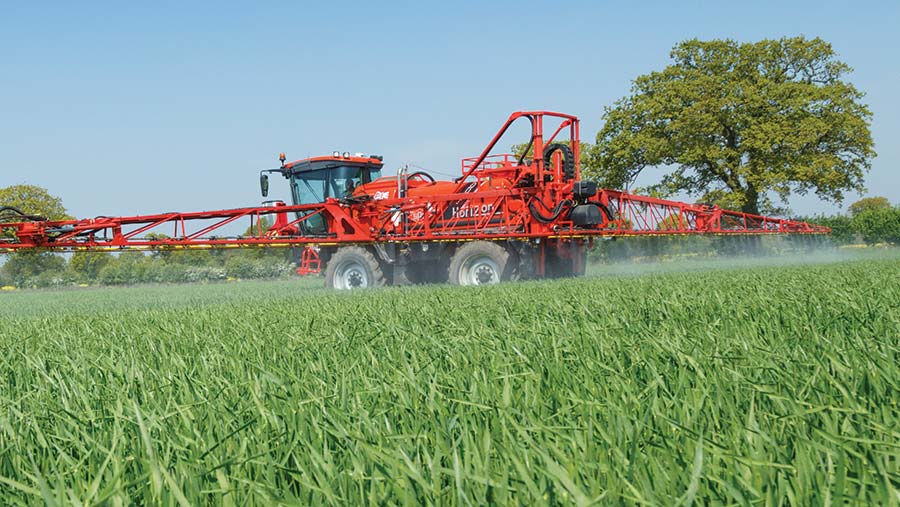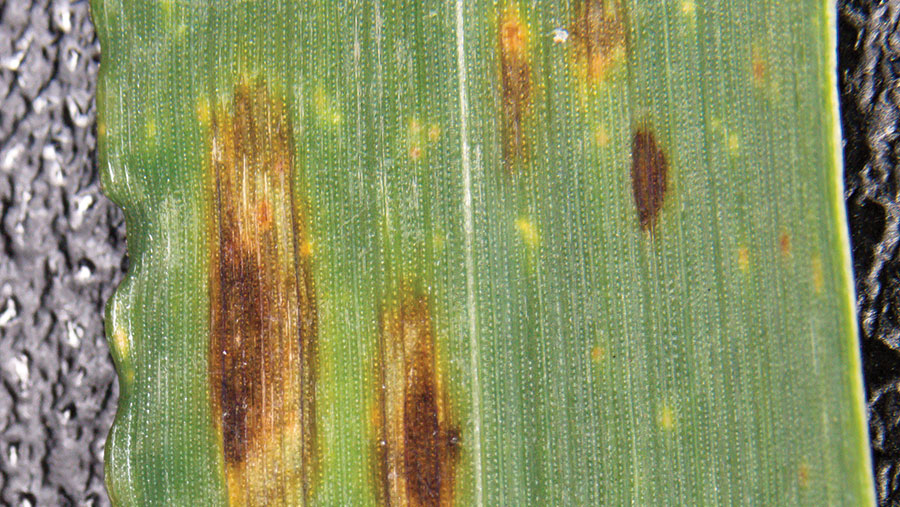How to manage ramularia without chlorothalonil
 © Gary Naylor
© Gary Naylor Scottish spring barley growers are being advised to minimise crop stress and tweak their fungicide programmes as they face the first season without chlorothalonil.
This year sees the withdrawal of the multisite fungicide, which has become the mainstay of ramularia control, as the disease has largely become resistant to the other key fungicide groups – azoles and SDHIs.
Growers can use existing stocks of the fungicide up to 20 May. While this means barley growers in the South and winter barley growers in the North get one last season, spring barley growers in Scotland will be the first to face a season without it.
See also: Why wheat growers may need to target mildew this spring
That’s because the key T2 fungicide timing for controlling the disease is well into June for spring barley north of the border. So how can growers avoid the potentially costly disease?
Risk factors
The starting point to manage the disease is to understand it and the risk factors.
Stewart Rothnie, an agronomist at Agrovista who advises on crops in Moray, says ramularia is actually a weak pathogen.
“It needs time to penetrate the leaf and feeds on pollen coming out of the head.”
In dry weather, pollen comes out and blows away, so it presents less of a problem. If it’s wet, the pollen sticks and the pathogen feeds on it, which is why the disease is more prevalent in wetter seasons, Mr Rothnie explains.
Disease control with fungicides is preventative, which is why timing is critical to protect the plant before any pollen is shed from the ears.
Stress is also a trigger for the disease. Therefore, growers should aim to minimise stress in crops, as well as getting plants fighting fit to better withstand any disease attacks.

© Blackthorn Arable
Nutrition
A good starting point is to ensure the plant is getting what it needs in terms of nutrition.
Mr Rothnie says soils in the area are low in copper, manganese, sulphur and zinc.
Growers can go with a manganese seed dressing and add some more foliar manganese, magnesium, copper and zinc in the post-emergence herbicide mix.
He is also looking to do more tissue testing this season to gain a detailed picture of what the crop needs as it develops rapidly.
“On Monday, you can have a bag of leaves off to the lab and by Thursday, you will know what is in the plant and whether the crop has any additional major or micro-nutritional needs.”
Mr Rothnie routinely adds magnesium sulphate with the flag leaf spray as there is extra demand for magnesium during grain fill. “It also helps to retain green leaf during the critical period.”
Adama’s recommendations for folpet use in spring barley
The manufacturer of folpet recommends a two-spray strategy for controlling ramularia in spring barley
- T1 (typically growth stage 25-30) – 0.75-1.0 litres/ha
- T2 (typically growth stage 39-49) – 1 litre/ha
Chemistry
Fungicide programmes will also have to change. Of the other two multisites, folpet is the only option, as mancozeb is only approved for wheat.
Some trials have shown limited success with folpet, but Mr Rothnie points out that growers would not use a multisite on its own. He also questions whether growers have also been underapplying it, because it costs more than chlorothalonil.
Growers have cut back rates to bring the price more in line with chlorothalonil and have been disappointed with the results. “Some were even using half rate.”
“However, if used at the recommended rate, it is just as effective as chlorothalonil,” he says.
Bayer’s commercial technical manager, Grant Reid, says a multisite will also help to protect other chemistry being used to manage other diseases. “So, there is a case to use folpet.”
Mr Reid also highlights the AHDB fungicide response curves showing prothioconazole is still doing something on ramularia when used to manage other diseases.
Mr Rothnie also sees a benefit with strobilurins, as they have beneficial effects on plant physiology.
“They turn on the plant and, in Scotland’s long days, it can help give an extra hour of sunlight through increases in photosynthesis. They also help reduce stress.”
Summary
- Minimise stress with adequate nutrition
- Folpet used at T2 instead of chlorothalonil
- Strobilurin and SDHIs offer physiological benefits and reduce stress
- Biostimulants may also have a role
Mr Reid says including an SDHI such as bixafen, with its physiological effects, can also help reduce stress, so again helps with ramularia.
There is also the new azole mefentrifluconazole, but there are restrictions on its use by the maltsters, with growers unable to use Revystar after growth stage 45 because of the SDHI (fluxpyroxad) and this may be too early for folpet.
One challenge with spring barley is that there is no time to work out the type of season. “The T1 and T2 spray interval should be three weeks, but has been just a matter of eight days apart in some seasons.”
Therefore, Mr Rothnie goes with a standard preventative approach (see “Spring barley inputs”) based on a prothoconazole/strobilurin mix plus a multisite.
Spring barley inputs
- Manganese seed treatment
- Pre-emergence herbicide Herold (diflufenican + flufenacet) + pendimethalin + Remix to tackle annual meadowgrass
- Or at four leaves Finish (metsulfuron + thifensulfuron) + Whorl (fluroxypyr + Halauxifen) + micronutrients + Terrasorb
- T1 Jaunt/Haven (fluoxastrobin + prothioconazole + trifloxystrobin) + manganese
- T2 (growth stage 49) Jaunt + multisite folpet + magnesium
Another challenge will be keeping costs down, considering the higher cost of folpet.
“The decision on rate will be based on the conditions at the time. If it is wet, we may need to go with a more robust rate.”
PGR, seed and biostimulants
If it’s a bad ramularia year, Mr Reid advises not home-saving seed, as there is a risk of carryover, especially as seed treatments are not effective.
Using growth regulator can also cause unnecessary stress in light, sandy loams, and Mr Rothnie tends to favour Canopy (mepiquat + prohexadione) over Moddus (trinexapac-ethyl), as it can be a bit harsh. However, by rate manipulation to environmental or varietal risk, both will deliver better roots and more robust straw.
Finally, biostimulants can also have a role in helping to reduce plant stress.
For example, Terra-Sorb is a mix of 18 amino acids, which are the building blocks of proteins. “Plants normally make their own, but if they get them, it saves time, helping reduce plant stress.”
Klorofill is another product that helps maximise the efficiency of chlorophyll production during rapid growth or stress, Mr Rothnie says.
“Up to now, they have been used as a fire engine when crops are yellowing and stressed.
“The thinking now is that they should be used on good crops and applied at the weed-killing stage to get better rooting and promote tillers, resulting in better establishment.”
Case study: Scott Campbell
Scott Campbell grows about 250ha of spring barley on his farm north-west of Aberdeen and is changing his ramularia strategy.
Until this season, chlorothalonil has been at the heart of his strategy, applied at the T2 timing before flowering.

Scott Campbell
Mr Campbell’s aim will be to get the crop as healthy as possible and avoid stress. Part of this is getting trace elements right.
Spring barley seed will be treated with a dressing containing copper and zinc, tailored to fields that have been identified to be at higher risk of deficiency from previous soil and tissue testing.
“Applying at T1 is too late, so we have been looking at seed treatments.”
He points to one trial where half the field received copper at T1, and the other half had the seed treatment. Tissue testing showed higher levels in the half that had a seed treatment, which shows it had been taken up by the plant.
Mr Campbell will also be applying bitter salts (magnesium sulphate) and he plan to keep an eye on soil phosphate (P) levels. “Plants seem to be more hardy with adequate P.”
In terms of fungicides, he will be relying on folpet, along with the new azole mefentrifluconazole (Revystar) at the key T2 timing, although he adds that any final decision will be based on conditions at the time.

